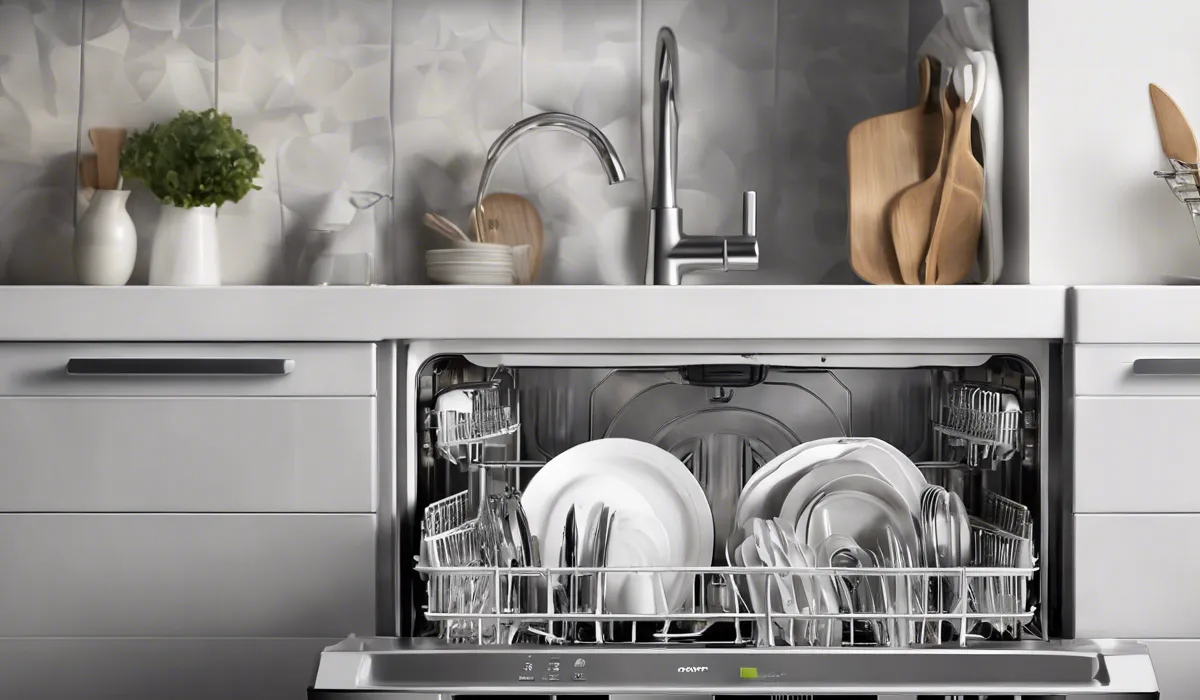How to Dry Dishes in Dishwasher: No More Spots!
To dry dishes in a dishwasher, use the heated dry setting if available. Open the door slightly after the cycle to let steam escape and air circulate. For plasticware, hand dry or leave for longer as it doesn’t retain heat well. Always unload the bottom rack first to prevent water from top dishes dripping onto dry ones.
Choosing the Right Dishwasher Cycle

Understanding Different Dishwasher Cycles
Dishwashers come with a variety of cycles, each designed for different types of dishwashing needs. The main cycles include Normal, Auto, Heavy, Light, and Quick.
The Normal cycle is suitable for a full load of dishes with an average soil level. Auto cycle senses the soil level and adjusts the wash settings accordingly.
Heavy is perfect for pots and pans, while Light is best for delicate items. Quick wash is a shorter cycle for lightly soiled dishes that do not need drying.
Benefits of Using a Heated Dry Option
The heated dry option uses a heating element to elevate the air temperature inside the dishwasher, thereby speeding up evaporation and leaving dishes dry.
This feature is particularly useful if you need your dishes ready for storage or use right after the cycle. The heat also helps sanitize your dishes, which is a bonus for cleanliness.
When to Opt for an Energy-Saving Dry Cycle
Energy-saving dry cycles, also known as eco-dry or air-dry, do not use the heating element. Instead, they rely on the residual heat from the wash cycle and the circulation of room air to dry dishes.
This cycle is more environmentally friendly and can help reduce your energy bill. It’s ideal for less urgent loads where you can afford to wait a bit longer for dishes to dry.
Loading the Dishwasher Properly

Arranging Dishes for Optimal Drying
To promote effective drying, it’s essential to load the dishwasher correctly. Place cups, glasses, and bowls on the top rack angled downwards so water can run off.
Pots, pans, and plates should go on the bottom rack angled slightly so the spray arm can reach inside them. By arranging your dishes this way, you allow air to circulate better, leading to drier dishes at the end of the cycle.
Importance of Spacing and Angling Dishes
Proper spacing between dishes is crucial for the water spray to reach all surfaces. Angling dishes properly ensures that water does not pool anywhere. This not only helps with cleaning but also with drying, as pooled water is less likely to evaporate.
Avoiding Nesting and Overcrowding
Nesting, or placing dishes inside one another, can prevent water from reaching all surfaces and hinder drying.
Overcrowding the dishwasher can also have the same effect. It’s important to load the dishwasher such that each dish has its own space, allowing for maximum efficiency during both washing and drying cycles.
Enhancing the Drying Process

Using Rinse Aid for Better Drying
Rinse aid is a surfactant that breaks the bond between water molecules and dishes, allowing water to sheet off smoothly. This can significantly improve the drying process by preventing water spots and streaks.
Most dishwashers have a dispenser that you can fill with rinse aid, and it’s automatically released during the final rinse cycle.
Opening the Dishwasher Door After the Cycle
Once the cycle is complete, opening the dishwasher door slightly can help release the hot steam and allow fresh air to circulate.
This can speed up the drying process, especially for dishwashers without a heated dry option. Just be careful not to burn yourself on the steam or hot dishes.
Removing Plastic Items That May Retain Moisture
Plastic items do not retain heat as well as glass or ceramic, which means they often come out of the dishwasher wet. It’s a good idea to remove these items and let them air dry or wipe them down with a towel to remove any remaining moisture.
Hand-Drying Tips for Stubborn Dampness
Sometimes, even after all these steps, you may find some dishes are still damp. For these stubborn cases, using a clean, dry dish towel to hand-dry dishes can be effective. Make sure to use a microfiber towel or one that does not leave lint behind.
FAQs About Drying Dishes in Dishwasher
How do I use the heated dry setting on my dishwasher?
To use the heated dry setting, select this option before starting the dishwasher cycle. Refer to your dishwasher’s manual for specific instructions, as settings may vary by model.
What should I do after the dishwasher cycle is complete?
Once the cycle is complete, open the dishwasher door slightly to let steam escape and allow air to circulate, which helps with the drying process.
What is the best way to dry plasticware in the dishwasher?
For plasticware, either hand dry with a towel or leave it in the dishwasher for a longer period after the cycle ends, as plastic doesn’t retain heat well and may not dry completely during the normal drying phase.
Should I unload the dishwasher’s top or bottom rack first?
Always unload the bottom rack first to prevent any residual water on the dishes in the top rack from dripping onto the items in the bottom rack, which may already be dry.
Do I need to hand dry dishes after using the dishwasher?
Hand drying may not be necessary if you use the heated dry setting and allow dishes to air dry after the cycle. However, some items, especially plastic, may require additional hand drying.
Final Thoughts
For optimally dry dishes in a dishwasher, utilize the heated dry option. After the cycle, crack the door to release steam and enhance air flow.
Plastic items, which cool quickly, may need extra hand drying or extended time. To avoid water drips on clean dishes, always start unloading with the bottom rack.





